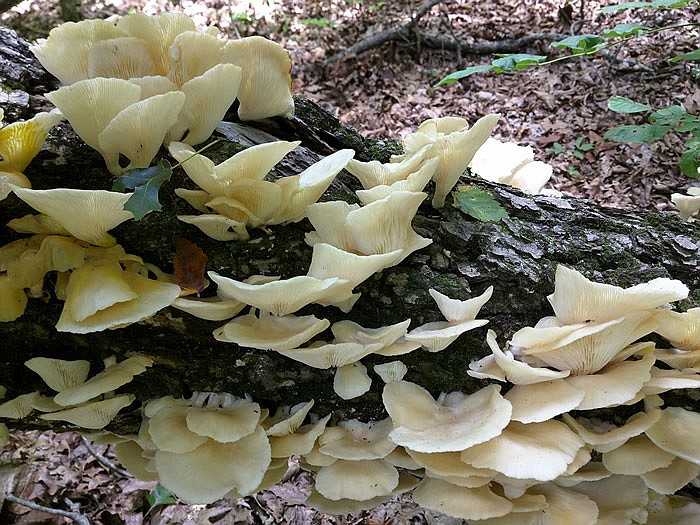Spring - and Morels and Microwbrews, Fulton's famed mushroom and beer festival - might seem like it's still a long way off. But even during these cold months, there are still mushrooms to be found.
"You can mushroom all year 'round," said Stephen Kistner, a conservation agent with the Missouri Department of Conservation. "In Missouri, everybody thinks morel, morel, morel but we've got edible mushrooms all year."
Here's a few easy-to-identify winter delights, some edible and some not, to keep an eye out for on your next wintry walk. You're most likely to spot them on above-freezing days after rain or a snow melt, so this week is a great time to go hunting. Kistner said wooded creek- and river-bottoms are a good place to look.
Grab a pocketknife, a bag and a good pair of boots and get hunting.
Oyster mushrooms (Pleurotus ostreatus)
Oyster mushrooms (in the Pleurotus genus) can be found all year in Missouri, and this species even sticks around for the winter.
"What they're looking at right now is mushrooms that popped in the fall and froze and they're still viable," Kistner said.
They're fairly large at about 2 to 6 inches across and pale in color, somewhere between white and light brown.
They grow in clusters on live and dead trees - typically hardwoods like oaks and maples.
On the underside of the slightly convex cap, there are distinct gills (wrinkles that hold the mushroom's spores) running down the wide, short stems. Place a cap on top of a black piece of paper under a glass overnight and in the morning you'll see a pale spore print.
Take a sniff - you'll notice a strong mushroom-y odor.
"The good thing about oysters is they don't really have any lookalikes in Missouri that'll hurt you," Kistner said.
Check for bugs before you harvest oyster mushrooms, because they tend to be invaded by little black beetles if you don't find them early enough.
Oyster mushrooms are delicious breaded and fried.
Turkey tail (Trametes versicolor)
Whether you know it or not, you've seen turkey tail mushrooms - they're one of the most common fungi in all of North America, and they're especially prominent in the winter.
Thin, flexible and fanlike or circular, turkey tail grows abundantly on decaying hardwood. Its color pattern is distinctive: bands of cream, cinnamon, brown and reddish. Sometimes they turn greenish with age as algae invades them.
"True turkey tail mushroooms are medicinal," Rogers said. "They usually can be boiled up for tea or some people make tinctures with them out of alcohol."
Some research indicates that turkey tail might have an immune-boosting effect, especially in cancer patients, though the FDA hasn't recognized it
As mentioned below, turkey tail has a similarly common lookalike, and others in the Trametes genus can look similar too.
"Turkey tail will have a very fine pored surface - if you look really close at the underside you'll see tiny pores," Rogers said.
Check out this site for more help with id-ing this fungus: bit.ly/2jCyyY1
False turkey tail (Stereum ostrea)
False turkey tail is true turkey tail's sneaky lookalike, without the rumored medicinal properties. From above, it looks nearly identical. The difference is down below.
"It looks like parchment - almost like the top of them," Rogers said. "It's flat."
The underside will lack even the tiniest of pores, instead being simply smooth.
Without any established uses, false turkey tail is pretty to look at but not worth collecting.
Wood ear (Auricularia auricula)
The wood ear is aptly named. A type of jelly fungus, it looks a lot like a slightly translucent, tan-brown ear, and even has a soft skin-like texture. As the "jelly fungus" moniker implies, it does have a jellylike, jiggly texture.
They spring up on decaying hardwood after rains and melts, though they don't last long. Skip over any that seem dried out around the edges or are slimy.
"I try to keep a stock on hand for cooking," Rogers said. "I'll put them in soups, or stir-fry them for a little texture."
While not often eaten in the U.S., wood ear and its close relatives are widely enjoyed across Asia, especially in hot-and-sour soup.
Disclaimer: the experts advise against eating any mushroom that you aren't absolutely positive about. Rogers recommends also studying up on poisonous mushrooms so you know what to avoid.
"One-hundred percent identify any mushroom before you eat it," Kistner said.
Michael Rogers, a Fulton local who's hunted mushrooms for many years, said not to be afraid to ask an expert.
"There are no stupid questions in this game," he said.
Want further identification help? MushroomExpert.com is a trusted online research, and the folks on the Missouri Mycological Society's Facebook group are also happy to confirm or aid in identification.
"There's a great publication that our department has: 'Missouri's Wild Mushrooms,'" Kistner said. "It's a very inexpensive book, and it has lots of gorgeous pictures. My copy's all dog-eared."

